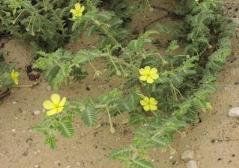
Tribulus terrestris / أبوضريس
Bullhead, Burra gokharu, Caltrop, Cat's head, Devil's eyelashes, Devil's thorn, Devil's weed, Goathead, Puncturevine
Qutheb, Abu theras, Hasak
Background
- Tribulus is an annual or biennial, prostrate, densely appressed whitish silky pubescent herb of the caltrop family (Zygophyllaceae)
- It grows in tropical and subtropical countries in Asia, Africa, S. Europe, and North Australia and introduced in new world tropics
- In the UAE, it is common and widespread in urban areas, roadsides and depressions
Part Used
Whole plant
Traditional and Medicinal Uses
Tribulus is traditionally known as an aphrodisiac in various cultures. It has been used as/for:
|
Aphrodisiac |
Diuretic |
Analgesic |
Enlarged spleen |
|
Hypotensive |
Dysuria |
Diarrhea |
Puerperal fever |
How Much Do We Know?
People use Tribulus for sexual disorders, infertility, chest pain, enlarged prostate, and many other conditions, but there is no good scientific evidence to support most of these uses.
What Do We Know About Safety?
- Tribulus is possibly safe for most people when taken at doses of 750-1500 mg daily for up to 90 days
- Eating the spine-covered fruit of Tribulus is likely unsafe. There have been reports of serious lung problems due to eating the fruit.
Using Senna by
Mouth
Tribulus has most often been used by adults in doses of 750-1200 mg by mouth daily for 12 weeks
Special Precautions & Warnings
Pregnancy
Possibly unsafe; taking Tribulus during pregnancy is unsafe. Animal research suggests that Tribulus might harm development of the fetus; avoid use
Breast-feeding
There isn't enough reliable information to know if Tribulus is safe to use when breast-feeding; avoid use.
Children
Likely unsafe; Don’t use
Keep in Mind
- Do not hesitate to speak with your health care provider before starting to use any supplements.
- Discuss potential benefits and risks, especially if you are suffering from any health problems.
